Hensoldt Storms The US Market
By David M. Fortier
©Copyright 2009, InterMedia Outdoors
When it comes to building high quality precision optics, Germany has been at it longer than anyone else. They have built a virtually unmatched reputation over the past two centuries. Their expertise in this area extends into the medical, sporting and even the military fields.
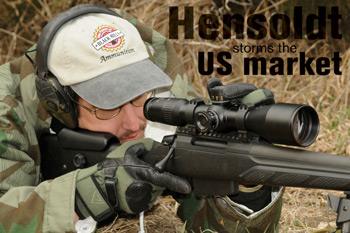
Carl Zeiss Optronics' military-grade Hensoldt line, like this 4-16 x 56mm tactical scope, is finally available here in the USA through importer HuDisCo. Quality is superb
Actually, when it comes to specialized military optics their experience dates back to the very genesis of modern sniping. In the filth, mud and death of the trenches during the Great War modern sniping was born unto the Germans. It was here, peering through Zielfernrohr-Gewehr 98s, that Imperial German Scharfshutzen (Sharpshooters) introduced a dark new face to war.
These prewar hunters and competitive shooters used stealth and precision rifle fire to make life hell in Allied trenches. While the German scopes of the day were relatively crude by today's standard, they did facilitate effective target engagement at both distance and in marginal light.
While many of the German optical firms which supplied scopes during these early years have vanished into the dust of history, two names remain with us today: Carl Zeiss and Hensoldt. Carl Zeiss is, of course, universally known and respected. Its sporting optics stand with the best in the world and have earned an enviable reputation for combining superb optical performance, trustworthy mechanics and handsome good looks into one neat package.
Hensoldt, though, is not as well known here in the USA, which is a pity. Now a part of the Zeiss Gruppe, Hensoldt specializes in producing top-tier optics for military and law enforcement. While its scopes have been unavailable here in recent years, after a long hiatus, the well-respected Hensoldt line is once again available to American riflemen through Hunt Distribution Company (HuDisCo).
HuDisCo was founded by a disabled U.S. Army veteran named Nathan Hunt. Hunt served as a Blackhawk crew chief in the 101st Airborne Division and then the highly respected 160th Special Operations Aviation Regiment (Airborne) known as the "Night Stalkers." During his time in the Army he logged five tours in Iraq with much of that spent behind a Dillon mini-gun. When he finally left the service, he worked as an armorer before going to work for Nightforce.
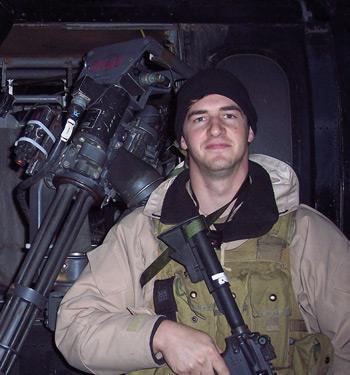
Nathan Hunt, the President of HuDisCo, stands in front of his mini-gun during his days in Iraq. His company is the exclusive distributor of Hensoldt here in the USA.
Although he spent much of his time behind a machine gun while in the Army, he had gained a keen appreciation for precision rifles from some of the units he worked with. This appreciation became first a hobby and then a professional interest while with Nightforce. Economics though eventually forced him to leave Nightforce and return to Alabama.
Perhaps it was due to his relative youth, or his special operations background or maybe he just didn't know better. Frankly I'm not sure, but after returning to Alabama, Hunt set out on a quest which I would have put money on as impossible. He formed HuDisCo and contacted Carl Zeiss about becoming the exclusive importer for the Hensoldt line of tactical optics. Why was I so skeptical?
Easy, many others, including Carl Zeiss USA, had tried for years to do this, and failed miserably. So when I walked in from the range one day to find a message on my answering machine from "Hensoldt's exclusive importer" my jaw dropped. I found it where it had rolled under a table and promptly gave him a call back.
He impressed me during our initial conversation, and has continued to impress me. So I stopped by his booth at the 2009 SHOT Show. Evidently word had gotten around as members from both the U.S. Army Marksmanship Unit and USMC Rifle Team had beaten me there. I was already familiar with the Hensoldt line, so I spent much of my time evaluating the man behind this new company. I found him to be very knowledgeable, good natured and extremely motivated.
As to be expected, five combat tours in Iraq sets him apart from your average company president. It appears Carl Zeiss Optronics leadership has chosen wisely, Hunt looks to be very well suited for the job which lies before him.
Now, understanding exactly how and where the Hensoldt line fits into the Zeiss Gruppe can be a bit difficult for many Americans, so let's start from the beginning. Carl Zeiss is a huge international company whose history dates back to its founding in Jena, Germany by Carl Friedrich Zeiss on November 17, 1846.
Zeiss began by building simple microscopes, which quickly earned a name for their quality. At this early stage, advances in optical designs and materials where mostly through trial and error. Carl Zeiss knew this to be inefficient, so he engaged a brilliant young lecturer (later Professor of Physics and Mathematics) named Ernst Abbe to help in this regard. Abbe would go on to make many breakthroughs in optical theory and design.
Rather than relying on trial on error, Abbe made a precise study of the materials to be used. The design was then specified by computation to the last detail–every curvature, every thickness, every aperture of a lens carefully calculated. This provided a substantial step forward in the design and manufacture of precision optics.
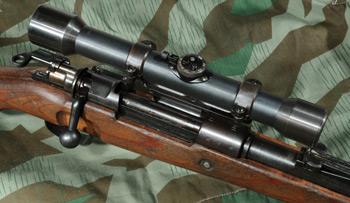
Although the early German sniper scopes
are crude by today's standards, they were the finest available in the world at the time and were highly prized.
Now, at this time one of the chief hurdles was the poor quality available optical glass. So in 1881 Abbe began working with a chemist named Otto Schott. Schott, like Abbe, then began to employ a scientific approach to determine the ingredients used in the manufacture of optical glass.
Schott's work went on to provide optical glass with a uniformity and purity previously unknown. The Schott Glaswerke then became the prime source of glass for Zeiss products, and subsequently became part of the Zeiss Gruppe. Later, on November 1, 1935, a Zeiss staff member (Alexander Smakula) developed and patented anti-reflective (T Transparenz) lens coatings. These dramatically improved light transmission and were considered a military secret until about 1940.
The optic itself is built on a robust 34mm tube and fitted with a 56mm objective lens. The fat tube gives it a nicely balanced look despite the large objective. More importantly, its large diameter also provides a wider range of movement for the erector system. This in turn leads to a much wider adjustment range.
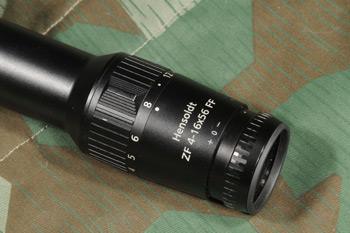
This is a logo that has until now only been seen on old surplus scopes. The Hensoldt line is produced by Carl Zeiss Optronics in Hensoldt's old factory in Wetzlar.
Although 40-42mm objectives are considered the standard in U.S. Army circles, bigger is often better. A larger objective lens theoretically provides not only increased light transmission and a larger exit pupil, but also greater resolution. Hensoldt has obviously designed this optic with low light in mind.
While objective lenses this large are not as popular in the United States as smaller diameters, they do offer very real advantages when shooting in low light. To better illustrate this, the 4-16x56mm Hensoldt generates a 14mm exit pupil at 4X, 6.2mm at 9X, 5.6mm at 10X and a still respectable 3.5mm when cranked all the up to 16X.
The ideal exit pupil size for low light use is approximately 6mm. The trade-off to the large diameter objective is, of course, a higher center-line and more glass to reflect light and disclose the sniper's position.
Magnification runs from a low of 4X up to a high of 16X. This fourfold increase is spread out to provide a very usable range. At the low end, 4X provides a wide field of view for engaging moving or suddenly appearing targets at close range. On the flip side, 16X provides more than enough magnification to identify and engage targets past 1000 yards without mirage severely degrading image quality. Field of view runs from 285 (4X) to 82 feet (16X) at 1,000 meters. Fitted to the ocular is a fast focus eye piece. Overall length is a relatively short 13.1 inches long. Weight is a fairly hefty 31.7 ounces.
Fitted to the center of the scope's tube is a spherical mechanism block. Mounted to this are very functional control turrets. Elevation and windage adjustments are made using large, well-marked target turrets. These feature precise tactile and audible clicks in .1 Mil (1cm) increments.
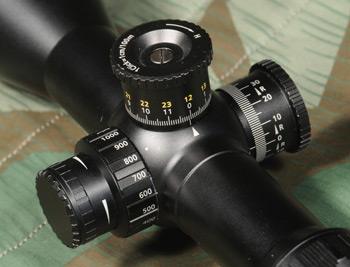
The elevation and windage turrets are well designed and sport very precise audible and tactile adjustments. The parallax knob is adjustable from 50m to infinity.
Total adjustment available is 22.4 Mils (224cm or 88.1 inches) for elevation and 10 Mils (100cm or 39.3 inches) for windage. Large enough to get the job done without being stupid, the turrets are very well designed. They contoured to provide a sure grip, even with wet, muddy or sweat covered fingers.
Markings are simple and easy to read with two rows of numerals. The bottom row is in white while the top row is in yellow. One full turret rotation provides 12 Mils (120cm or 47.2 inches) of adjustment. Halfway through the rotation a yellow line below the knob comes into view. After a rifleman has made one full rotation he switches and uses the top row of numbers if additional elevation is required.
The elevation turret provides approximately 1.5 rotations of usable elevation (approximately 70 inches). This is substantially more elevation than is required to take a .308 Win. chambered rifle from 100 to 1000 yards. The well thoughtout design means there is no chance of a rifleman losing track of turret rotations.
While some may initially be put off by the turret graduations being in .1 Mil/1cm increments, they do offer an advantage. Since the reticle is delineated in mils, it makes sense to graduate the adjustments in the same manner. This allows a rifleman to quickly use his come-up data on either the turret or on the reticle.
In addition, if he fires a shot and misses, but sees the impact, he can quickly use his reticle to measure his correction and apply it directly to his turrets.
Over the years I have come to the conclusion it's best to have mil adjustments with a mil-based reticle and moa adjustments with an moa-based reticle.
Mounted to the left side of the mechanism block is a large smooth adjusting parallax knob. Parallax can be adjusted from 50m to infinity. Mounted to the parallax knob is a smaller rheostat which controls the intensity of the reticle when illuminated. The rheostat, as it was designed for military use, is a bit different than most currently out there.
The unit itself is powered by a common CR2032 3-volt battery and controlled by a microprocessor. Carl Zeiss introduced their first production rifle scopes, the Zieldovier 1+4X20 and Zieldosechs 1+6x31, featuring an illuminated reticle way back in 1921. So they have a bit of expertise in this area.
A conventional push/pull illumination system (such as utilized on Carl Zeiss sporting scopes) is not utilized. Why? It was found that at high altitude (such as if a sniper team being inserted by helicopter) the combination of high altitude and nitrogen pressurization would cause the knob to pop out and activate the illumination. Instead this Hensoldt is fitted with a system where you rotate the rheostat to turn the illumination and to adjust its intensity. To turn it off you push in on the knob. When you turn it again, it returns to its last intensity setting. Incorporated in the design is a three hour auto shut-off to prevent it from being accidentally left on and draining the battery.
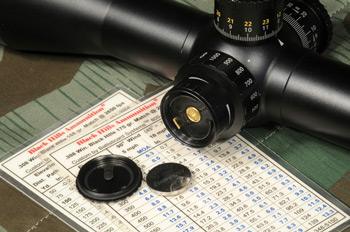
The scope's illuminated reticle is powered by a common CR2032 battery and is controlled by a microprocessor. It's simple to use and is also night vision compatible.
A conventional Mil-Dot reticle is mounted in the front focal plane. By placing the reticle in the front, rather than rear, focal plane targets may be mil'd at any magnification setting. So, unlike the majority of tactical scopes currently available, the reticle is usable across the entire magnification range.
You are not forced to set it at 10X or 12X if you want to Mil a target or if you want to use the reticle for elevation/windage corrections. This is a very desirable feature American marksmen have only begun to embrace over the last few years.
In addition a choke rangefinder is included that allows ranging a one-meter tall target from 200-1000 meters. Located below the mil reticle, this system is fast and simple to use. You simply place the target's belt line on the bottom horizontal line and the line the head touches is the range.
Hensoldt fully multi-coats lenses with Carl Zeiss's well respected T* anti-reflective coatings. These are applied to apochromatic fluorite glass lenses. This type of lens is superior at correcting chromatic and spherical aberrations. It aligns the three main color spectrums and eliminates multiple light focal points. This greatly limits color fringing. The result is not only a superior image, but also lighter weight compared to traditional lenses ground from lead glass.
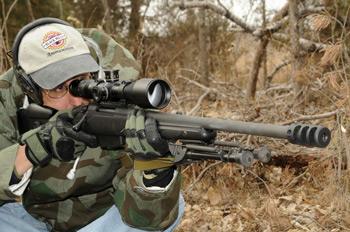
When put to work on the range, the Hensoldt proved to be a top-tier optic. Fortier says mechanical performance was flawless and optical performance was superb.
To check the Hensoldt's performance, I mounted it onto Sako TRG-22 and then a Tikka Tactical using a set of Warne 34mm rings. I began by zeroing it at 100 yards and boxing it. Zeroing was easily accomplished and the Hensoldt passed the box test perfectly. Adjustments were dead on and repeatable.
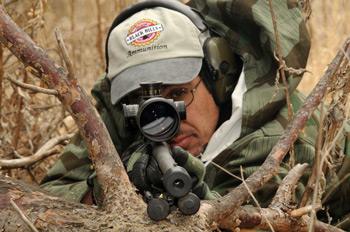
The Hensoldt's turrets are well suited for field use, providing 12 mils of adjustment per full revolution. The first focal plane reticle is also very user friendly.
Pulling out my rifle's data book, I next moved to my shoot tower and engaged resetting steel targets from 200 to 600 yards. This was easily accomplished. During this portion of testing the Hensoldt acted like the thoroughbred it is.
The magnification ring adjusted smoothly, the parallax knob was easy to adjust and the turrets provided crisp corrections. Performance was monotonous. You dialed the adjustments in and the Sako put a hole in what you were aiming at.
So I next moved to testing the Hensoldt's optical performance. In bright light I noted the color rendition to be very accurate but perhaps slightly on the warm side. I noticed no barrel, pincushion or rolling distortion.
Resolution, all the way through the magnification range, was excellent at 100 yards. Peering at an old barn, I could see the finest details of the peeling paint and worn wood beneath. Next I moved to observing at long distances. Unlimbering an old Wild coincidental artillery rangefinder, I ranged a distant rock pile. It came in at 1300 meters.
Next, I compared the Hensoldt to a Nightforce 3.5-15x50mm. With both scopes rested I went back and forth between the two trying to discern the finest details of the rocks on the distant pile. While the Nightforce fared very well, it came out on the short end of the stick when going head to head with the Hensoldt at identical magnification settings. Optical image quality of the Hensoldt proved to be extremely good, from the center to almost, but not quite, the very edge.
I finished testing by using the Hensoldt in low light and complete darkness. Low light performance was also very good. Here the 56mm objective showed its worth and allowed targets to be successfully engaged long after they were no longer visible with the naked eye. During low light testing I also gained an appreciation for the illuminated reticle. On too many scopes, the reticle intensity is far too bright, even on the lowest setting. Many wash the image out, negating any positive benefit they may afford. I was able to adjust the Hensoldt, on the other hand, to fit the conditions perfectly. When darkness meant I could no longer see through the scope, I fitted it with a PVS-14 night vision monocular. Normally, I am not a big fan of using a PVS-14 in this manner, as its performance is dramatically degraded. However, results with the Hensoldt were better than expected with the magnification set on 4X.
The reticle's intensity could also be easily adjusted to the proper level for use with the night vision device. However, a dedicated objective-mounted night vision device specifically made for this application is the way to go.
My thoughts? This is an impressive scope built like a brick. Optically it possesses a bright image with excellent color rendition and extremely good resolution. German optics have an impressive reputation for a reason, they kick butt. Negatives? Yes there are two. One is minor. I noted a small amount of tunneling from 4X to about 4.4X. The other concerns the price, which is a jaw-dropping $3,499.
Not only is Hensoldt's 4-16x56mm a true military grade tactical scope, but it's priced in the finest Teutonic tradition. While I could probably justify paying such a sum if my chosen vocation was as a professional marksman, most casual shooters cannot. However this does not take away from the simple fact that this is an outstanding optic. It certainly is among, and possibly is, the finest I have ever had the pleasure of using. It does everything exceptionally well.
The other optic I tested was Carl Zeiss Optronic's Spotter 60 spotting scope. Initially one would think that this optic was fitted with a 60mm objective, due to its name. However, the 60 refers to highest magnification, 60X. A porro prism design, this compact spotting scope is actually fitted with a 72mm objective lens. A variable power eyepiece is fitted which zooms from 20-60X. To protect it from knocks and blows, the lightweight body is encased in protective rubber armor.
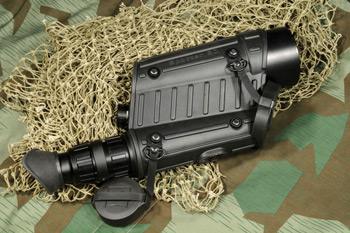
Also tested was this 20-60 x 72mm spotting scope called the Spotter 60. It's not intended for birding; it's a specialized unit developed specifically for snipers.
The fat 72mm objective lens generates an exit pupil running from 3.6 to 1.2mm. Field of view runs from 160.7 to 62.3 feet at 1000 meters. Overall length is 13.1 inches, it's 3.9 inches wide and 6.4 inches tall. Weight comes in at a slightly hefty 56.4 ounces.
Although at first glance the Spotter 60 looks similar in profile to some other spotting scopes out there, it easily stands out from the crowd. How? Well, not only does it have a rangefinding reticle, but it's located in the first focal plane. This allows it to be used at any magnification range.
The few other spotting scopes out there that offer rangefinding reticles do so using a fixed magnification (usually 30X) eyepiece. Not only does the Spotter 60 offer a mil reticle in the first focal plane, but it even offers illumination for use in low light. Located at the rear of the scope body, just above the eyepiece is a rheostat. This operates identically to the rheostat mounted on the 4-16x56mm.
The reticle incorporated in the design consists of L-shaped stadia. These are of equal length and delineate 10 mils each. A small fine crosshair is in the center of the field of view. The L-shaped stadia allows a spotter to range targets and quickly provide corrections to a sniper without the reticle obscuring any of his field of view.
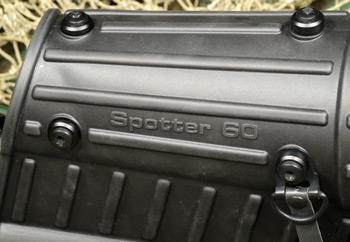
The Spotter 60's body has multiple hard mounting points. This allows short sections of 1913 rails to be added to allow tactical accessories easily to be mounted.
The body of the optic also features multiple mounting points for short sections of Mil Std 1913 rails. These are provided both on the side and top of the optic. By adding rail sections, a spotter can then mount mission essential accessories directly to his spotting scope. These can include, but are not limited to, night vision devices, IR laser/illuminator or even a white light. Sling attachment points are also provided on each side of the optic.
Optically the Spotter 60 sports Carl Zeiss's well respected T* lens coatings on all lens surfaces. Rather than traditional lead glass lenses, fluorite crystal super achromatic lenses are utilized. These have several advantages. They correct for spherical aberration and correct the visible light spectrum. In addition they also align the infrared color spectrum with the visible spectrum. Plus the folded path design provides a much longer focal length, over 18 inches, which further improves performance.
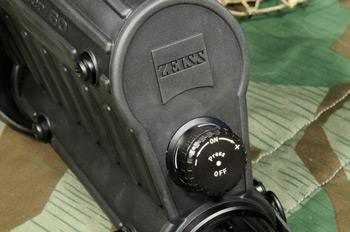
Rotate the rheostat knob to activate the reticle and adjust its intensity. Push in to turn it off. When you turn it on again, it returns to its last intensity setting.
Performance of the Spotter 60 is extremely good. I noticed no barrel, pincushion or rolling distortion. Color rendition was excellent, but again just a touch on the warm side. Resolution was extremely good. To test the resolution I decided to run the Spotter 60 head to head with another high end spotting scope.
Since the 4-16x56mm had pummeled a domestic scope I decided it best to pit the Spotter 60 against a top European spotter. So I rummaged around and found an Optolyth MiniB/GA 15-45x80mm collapsible spotting scope. So it was two very differently designed German spotting scopes intended for field use. I put them to work at 100 and 1300 meters on a sunny day and they immediately began putting the knuckles to each other.
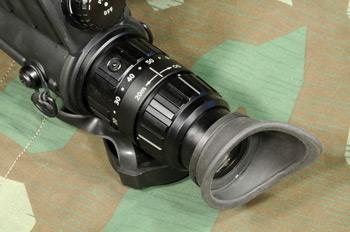
The Spotter 60 zooms from 20X up to 60X. Thanks to the reticle being in the front focal plane, it can be used for ranging and corrections at any magnification.
It proved to be a real down and dirty brawl with the Optolyth standing toe to toe with the much higher priced Hensoldt. Both these optics are very impressive and well suited for their intended functions. In the end though, I was able to discern just a tiny bit more fine detail at 1300 meters, on the same magnification setting, with the Spotter 60. I will say the Optolyth is an impressive spotting scope, look for a full review in the future.
Low light performance of the Spotter 60 was also very good. During this portion of testing it was used both with and without a PVS-14. The illuminated reticle also performed very well. The reticle itself is well designed and easy to use. At the same time, it does not clutter up the field of view like some more complex designs. All in all the Spotter60 is a fantastic piece of kit.
Gripes? If I was going to complain, the only things I could touch on would be the weight and the price. It is a little on the porky side, but I can deal with that. The price, though, is an out of this world $4,999. It's not very often you come across a day optic that makes a PVS-14 look cheap.
However, in this regard the Spotter 60 mocked my inexpensive3rd Generation U.S. night vision device. If you can afford the price, God bless you, it's a fantastic optical instrument. I however will be carefully insuring the package when I ship it back though.
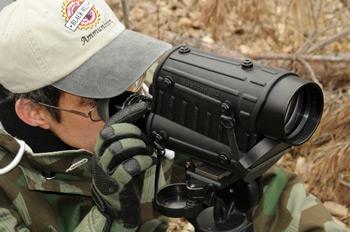
Fortier found that optical performance of the Spotter 60 was excellent with accurate color rendition, excellent resolution and extremely good low light performance.
Final thoughts? There is a reason the German Army fields Hensoldt sniper scopes. Both of these optical devices utilize all of the most advanced optical technologies currently available to designers. They are precision optical instruments made to endure the harshest of environments, the modern battlefield. If you have need of a superb military grade optic, and can afford the price of admission, consider Hensoldt. After all, they have been building optics for military snipers since the dawn of modern sniping itself.
By David M. Fortier
©Copyright 2009, InterMedia Outdoors
When it comes to building high quality precision optics, Germany has been at it longer than anyone else. They have built a virtually unmatched reputation over the past two centuries. Their expertise in this area extends into the medical, sporting and even the military fields.

Carl Zeiss Optronics' military-grade Hensoldt line, like this 4-16 x 56mm tactical scope, is finally available here in the USA through importer HuDisCo. Quality is superb
Actually, when it comes to specialized military optics their experience dates back to the very genesis of modern sniping. In the filth, mud and death of the trenches during the Great War modern sniping was born unto the Germans. It was here, peering through Zielfernrohr-Gewehr 98s, that Imperial German Scharfshutzen (Sharpshooters) introduced a dark new face to war.
These prewar hunters and competitive shooters used stealth and precision rifle fire to make life hell in Allied trenches. While the German scopes of the day were relatively crude by today's standard, they did facilitate effective target engagement at both distance and in marginal light.
While many of the German optical firms which supplied scopes during these early years have vanished into the dust of history, two names remain with us today: Carl Zeiss and Hensoldt. Carl Zeiss is, of course, universally known and respected. Its sporting optics stand with the best in the world and have earned an enviable reputation for combining superb optical performance, trustworthy mechanics and handsome good looks into one neat package.
Hensoldt, though, is not as well known here in the USA, which is a pity. Now a part of the Zeiss Gruppe, Hensoldt specializes in producing top-tier optics for military and law enforcement. While its scopes have been unavailable here in recent years, after a long hiatus, the well-respected Hensoldt line is once again available to American riflemen through Hunt Distribution Company (HuDisCo).
HuDisCo was founded by a disabled U.S. Army veteran named Nathan Hunt. Hunt served as a Blackhawk crew chief in the 101st Airborne Division and then the highly respected 160th Special Operations Aviation Regiment (Airborne) known as the "Night Stalkers." During his time in the Army he logged five tours in Iraq with much of that spent behind a Dillon mini-gun. When he finally left the service, he worked as an armorer before going to work for Nightforce.

Nathan Hunt, the President of HuDisCo, stands in front of his mini-gun during his days in Iraq. His company is the exclusive distributor of Hensoldt here in the USA.
Although he spent much of his time behind a machine gun while in the Army, he had gained a keen appreciation for precision rifles from some of the units he worked with. This appreciation became first a hobby and then a professional interest while with Nightforce. Economics though eventually forced him to leave Nightforce and return to Alabama.
Perhaps it was due to his relative youth, or his special operations background or maybe he just didn't know better. Frankly I'm not sure, but after returning to Alabama, Hunt set out on a quest which I would have put money on as impossible. He formed HuDisCo and contacted Carl Zeiss about becoming the exclusive importer for the Hensoldt line of tactical optics. Why was I so skeptical?
Easy, many others, including Carl Zeiss USA, had tried for years to do this, and failed miserably. So when I walked in from the range one day to find a message on my answering machine from "Hensoldt's exclusive importer" my jaw dropped. I found it where it had rolled under a table and promptly gave him a call back.
He impressed me during our initial conversation, and has continued to impress me. So I stopped by his booth at the 2009 SHOT Show. Evidently word had gotten around as members from both the U.S. Army Marksmanship Unit and USMC Rifle Team had beaten me there. I was already familiar with the Hensoldt line, so I spent much of my time evaluating the man behind this new company. I found him to be very knowledgeable, good natured and extremely motivated.
As to be expected, five combat tours in Iraq sets him apart from your average company president. It appears Carl Zeiss Optronics leadership has chosen wisely, Hunt looks to be very well suited for the job which lies before him.
Now, understanding exactly how and where the Hensoldt line fits into the Zeiss Gruppe can be a bit difficult for many Americans, so let's start from the beginning. Carl Zeiss is a huge international company whose history dates back to its founding in Jena, Germany by Carl Friedrich Zeiss on November 17, 1846.
Zeiss began by building simple microscopes, which quickly earned a name for their quality. At this early stage, advances in optical designs and materials where mostly through trial and error. Carl Zeiss knew this to be inefficient, so he engaged a brilliant young lecturer (later Professor of Physics and Mathematics) named Ernst Abbe to help in this regard. Abbe would go on to make many breakthroughs in optical theory and design.
Rather than relying on trial on error, Abbe made a precise study of the materials to be used. The design was then specified by computation to the last detail–every curvature, every thickness, every aperture of a lens carefully calculated. This provided a substantial step forward in the design and manufacture of precision optics.

Although the early German sniper scopes
are crude by today's standards, they were the finest available in the world at the time and were highly prized.
Now, at this time one of the chief hurdles was the poor quality available optical glass. So in 1881 Abbe began working with a chemist named Otto Schott. Schott, like Abbe, then began to employ a scientific approach to determine the ingredients used in the manufacture of optical glass.
Schott's work went on to provide optical glass with a uniformity and purity previously unknown. The Schott Glaswerke then became the prime source of glass for Zeiss products, and subsequently became part of the Zeiss Gruppe. Later, on November 1, 1935, a Zeiss staff member (Alexander Smakula) developed and patented anti-reflective (T Transparenz) lens coatings. These dramatically improved light transmission and were considered a military secret until about 1940.
The optic itself is built on a robust 34mm tube and fitted with a 56mm objective lens. The fat tube gives it a nicely balanced look despite the large objective. More importantly, its large diameter also provides a wider range of movement for the erector system. This in turn leads to a much wider adjustment range.

This is a logo that has until now only been seen on old surplus scopes. The Hensoldt line is produced by Carl Zeiss Optronics in Hensoldt's old factory in Wetzlar.
Although 40-42mm objectives are considered the standard in U.S. Army circles, bigger is often better. A larger objective lens theoretically provides not only increased light transmission and a larger exit pupil, but also greater resolution. Hensoldt has obviously designed this optic with low light in mind.
While objective lenses this large are not as popular in the United States as smaller diameters, they do offer very real advantages when shooting in low light. To better illustrate this, the 4-16x56mm Hensoldt generates a 14mm exit pupil at 4X, 6.2mm at 9X, 5.6mm at 10X and a still respectable 3.5mm when cranked all the up to 16X.
The ideal exit pupil size for low light use is approximately 6mm. The trade-off to the large diameter objective is, of course, a higher center-line and more glass to reflect light and disclose the sniper's position.
Magnification runs from a low of 4X up to a high of 16X. This fourfold increase is spread out to provide a very usable range. At the low end, 4X provides a wide field of view for engaging moving or suddenly appearing targets at close range. On the flip side, 16X provides more than enough magnification to identify and engage targets past 1000 yards without mirage severely degrading image quality. Field of view runs from 285 (4X) to 82 feet (16X) at 1,000 meters. Fitted to the ocular is a fast focus eye piece. Overall length is a relatively short 13.1 inches long. Weight is a fairly hefty 31.7 ounces.
Fitted to the center of the scope's tube is a spherical mechanism block. Mounted to this are very functional control turrets. Elevation and windage adjustments are made using large, well-marked target turrets. These feature precise tactile and audible clicks in .1 Mil (1cm) increments.

The elevation and windage turrets are well designed and sport very precise audible and tactile adjustments. The parallax knob is adjustable from 50m to infinity.
Total adjustment available is 22.4 Mils (224cm or 88.1 inches) for elevation and 10 Mils (100cm or 39.3 inches) for windage. Large enough to get the job done without being stupid, the turrets are very well designed. They contoured to provide a sure grip, even with wet, muddy or sweat covered fingers.
Markings are simple and easy to read with two rows of numerals. The bottom row is in white while the top row is in yellow. One full turret rotation provides 12 Mils (120cm or 47.2 inches) of adjustment. Halfway through the rotation a yellow line below the knob comes into view. After a rifleman has made one full rotation he switches and uses the top row of numbers if additional elevation is required.
The elevation turret provides approximately 1.5 rotations of usable elevation (approximately 70 inches). This is substantially more elevation than is required to take a .308 Win. chambered rifle from 100 to 1000 yards. The well thoughtout design means there is no chance of a rifleman losing track of turret rotations.
While some may initially be put off by the turret graduations being in .1 Mil/1cm increments, they do offer an advantage. Since the reticle is delineated in mils, it makes sense to graduate the adjustments in the same manner. This allows a rifleman to quickly use his come-up data on either the turret or on the reticle.
In addition, if he fires a shot and misses, but sees the impact, he can quickly use his reticle to measure his correction and apply it directly to his turrets.
Over the years I have come to the conclusion it's best to have mil adjustments with a mil-based reticle and moa adjustments with an moa-based reticle.
Mounted to the left side of the mechanism block is a large smooth adjusting parallax knob. Parallax can be adjusted from 50m to infinity. Mounted to the parallax knob is a smaller rheostat which controls the intensity of the reticle when illuminated. The rheostat, as it was designed for military use, is a bit different than most currently out there.
The unit itself is powered by a common CR2032 3-volt battery and controlled by a microprocessor. Carl Zeiss introduced their first production rifle scopes, the Zieldovier 1+4X20 and Zieldosechs 1+6x31, featuring an illuminated reticle way back in 1921. So they have a bit of expertise in this area.
A conventional push/pull illumination system (such as utilized on Carl Zeiss sporting scopes) is not utilized. Why? It was found that at high altitude (such as if a sniper team being inserted by helicopter) the combination of high altitude and nitrogen pressurization would cause the knob to pop out and activate the illumination. Instead this Hensoldt is fitted with a system where you rotate the rheostat to turn the illumination and to adjust its intensity. To turn it off you push in on the knob. When you turn it again, it returns to its last intensity setting. Incorporated in the design is a three hour auto shut-off to prevent it from being accidentally left on and draining the battery.

The scope's illuminated reticle is powered by a common CR2032 battery and is controlled by a microprocessor. It's simple to use and is also night vision compatible.
A conventional Mil-Dot reticle is mounted in the front focal plane. By placing the reticle in the front, rather than rear, focal plane targets may be mil'd at any magnification setting. So, unlike the majority of tactical scopes currently available, the reticle is usable across the entire magnification range.
You are not forced to set it at 10X or 12X if you want to Mil a target or if you want to use the reticle for elevation/windage corrections. This is a very desirable feature American marksmen have only begun to embrace over the last few years.
In addition a choke rangefinder is included that allows ranging a one-meter tall target from 200-1000 meters. Located below the mil reticle, this system is fast and simple to use. You simply place the target's belt line on the bottom horizontal line and the line the head touches is the range.
Hensoldt fully multi-coats lenses with Carl Zeiss's well respected T* anti-reflective coatings. These are applied to apochromatic fluorite glass lenses. This type of lens is superior at correcting chromatic and spherical aberrations. It aligns the three main color spectrums and eliminates multiple light focal points. This greatly limits color fringing. The result is not only a superior image, but also lighter weight compared to traditional lenses ground from lead glass.

When put to work on the range, the Hensoldt proved to be a top-tier optic. Fortier says mechanical performance was flawless and optical performance was superb.
To check the Hensoldt's performance, I mounted it onto Sako TRG-22 and then a Tikka Tactical using a set of Warne 34mm rings. I began by zeroing it at 100 yards and boxing it. Zeroing was easily accomplished and the Hensoldt passed the box test perfectly. Adjustments were dead on and repeatable.

The Hensoldt's turrets are well suited for field use, providing 12 mils of adjustment per full revolution. The first focal plane reticle is also very user friendly.
Pulling out my rifle's data book, I next moved to my shoot tower and engaged resetting steel targets from 200 to 600 yards. This was easily accomplished. During this portion of testing the Hensoldt acted like the thoroughbred it is.
The magnification ring adjusted smoothly, the parallax knob was easy to adjust and the turrets provided crisp corrections. Performance was monotonous. You dialed the adjustments in and the Sako put a hole in what you were aiming at.
So I next moved to testing the Hensoldt's optical performance. In bright light I noted the color rendition to be very accurate but perhaps slightly on the warm side. I noticed no barrel, pincushion or rolling distortion.
Resolution, all the way through the magnification range, was excellent at 100 yards. Peering at an old barn, I could see the finest details of the peeling paint and worn wood beneath. Next I moved to observing at long distances. Unlimbering an old Wild coincidental artillery rangefinder, I ranged a distant rock pile. It came in at 1300 meters.
Next, I compared the Hensoldt to a Nightforce 3.5-15x50mm. With both scopes rested I went back and forth between the two trying to discern the finest details of the rocks on the distant pile. While the Nightforce fared very well, it came out on the short end of the stick when going head to head with the Hensoldt at identical magnification settings. Optical image quality of the Hensoldt proved to be extremely good, from the center to almost, but not quite, the very edge.
I finished testing by using the Hensoldt in low light and complete darkness. Low light performance was also very good. Here the 56mm objective showed its worth and allowed targets to be successfully engaged long after they were no longer visible with the naked eye. During low light testing I also gained an appreciation for the illuminated reticle. On too many scopes, the reticle intensity is far too bright, even on the lowest setting. Many wash the image out, negating any positive benefit they may afford. I was able to adjust the Hensoldt, on the other hand, to fit the conditions perfectly. When darkness meant I could no longer see through the scope, I fitted it with a PVS-14 night vision monocular. Normally, I am not a big fan of using a PVS-14 in this manner, as its performance is dramatically degraded. However, results with the Hensoldt were better than expected with the magnification set on 4X.
The reticle's intensity could also be easily adjusted to the proper level for use with the night vision device. However, a dedicated objective-mounted night vision device specifically made for this application is the way to go.
My thoughts? This is an impressive scope built like a brick. Optically it possesses a bright image with excellent color rendition and extremely good resolution. German optics have an impressive reputation for a reason, they kick butt. Negatives? Yes there are two. One is minor. I noted a small amount of tunneling from 4X to about 4.4X. The other concerns the price, which is a jaw-dropping $3,499.
Not only is Hensoldt's 4-16x56mm a true military grade tactical scope, but it's priced in the finest Teutonic tradition. While I could probably justify paying such a sum if my chosen vocation was as a professional marksman, most casual shooters cannot. However this does not take away from the simple fact that this is an outstanding optic. It certainly is among, and possibly is, the finest I have ever had the pleasure of using. It does everything exceptionally well.
The other optic I tested was Carl Zeiss Optronic's Spotter 60 spotting scope. Initially one would think that this optic was fitted with a 60mm objective, due to its name. However, the 60 refers to highest magnification, 60X. A porro prism design, this compact spotting scope is actually fitted with a 72mm objective lens. A variable power eyepiece is fitted which zooms from 20-60X. To protect it from knocks and blows, the lightweight body is encased in protective rubber armor.

Also tested was this 20-60 x 72mm spotting scope called the Spotter 60. It's not intended for birding; it's a specialized unit developed specifically for snipers.
The fat 72mm objective lens generates an exit pupil running from 3.6 to 1.2mm. Field of view runs from 160.7 to 62.3 feet at 1000 meters. Overall length is 13.1 inches, it's 3.9 inches wide and 6.4 inches tall. Weight comes in at a slightly hefty 56.4 ounces.
Although at first glance the Spotter 60 looks similar in profile to some other spotting scopes out there, it easily stands out from the crowd. How? Well, not only does it have a rangefinding reticle, but it's located in the first focal plane. This allows it to be used at any magnification range.
The few other spotting scopes out there that offer rangefinding reticles do so using a fixed magnification (usually 30X) eyepiece. Not only does the Spotter 60 offer a mil reticle in the first focal plane, but it even offers illumination for use in low light. Located at the rear of the scope body, just above the eyepiece is a rheostat. This operates identically to the rheostat mounted on the 4-16x56mm.
The reticle incorporated in the design consists of L-shaped stadia. These are of equal length and delineate 10 mils each. A small fine crosshair is in the center of the field of view. The L-shaped stadia allows a spotter to range targets and quickly provide corrections to a sniper without the reticle obscuring any of his field of view.

The Spotter 60's body has multiple hard mounting points. This allows short sections of 1913 rails to be added to allow tactical accessories easily to be mounted.
The body of the optic also features multiple mounting points for short sections of Mil Std 1913 rails. These are provided both on the side and top of the optic. By adding rail sections, a spotter can then mount mission essential accessories directly to his spotting scope. These can include, but are not limited to, night vision devices, IR laser/illuminator or even a white light. Sling attachment points are also provided on each side of the optic.
Optically the Spotter 60 sports Carl Zeiss's well respected T* lens coatings on all lens surfaces. Rather than traditional lead glass lenses, fluorite crystal super achromatic lenses are utilized. These have several advantages. They correct for spherical aberration and correct the visible light spectrum. In addition they also align the infrared color spectrum with the visible spectrum. Plus the folded path design provides a much longer focal length, over 18 inches, which further improves performance.

Rotate the rheostat knob to activate the reticle and adjust its intensity. Push in to turn it off. When you turn it on again, it returns to its last intensity setting.
Performance of the Spotter 60 is extremely good. I noticed no barrel, pincushion or rolling distortion. Color rendition was excellent, but again just a touch on the warm side. Resolution was extremely good. To test the resolution I decided to run the Spotter 60 head to head with another high end spotting scope.
Since the 4-16x56mm had pummeled a domestic scope I decided it best to pit the Spotter 60 against a top European spotter. So I rummaged around and found an Optolyth MiniB/GA 15-45x80mm collapsible spotting scope. So it was two very differently designed German spotting scopes intended for field use. I put them to work at 100 and 1300 meters on a sunny day and they immediately began putting the knuckles to each other.

The Spotter 60 zooms from 20X up to 60X. Thanks to the reticle being in the front focal plane, it can be used for ranging and corrections at any magnification.
It proved to be a real down and dirty brawl with the Optolyth standing toe to toe with the much higher priced Hensoldt. Both these optics are very impressive and well suited for their intended functions. In the end though, I was able to discern just a tiny bit more fine detail at 1300 meters, on the same magnification setting, with the Spotter 60. I will say the Optolyth is an impressive spotting scope, look for a full review in the future.
Low light performance of the Spotter 60 was also very good. During this portion of testing it was used both with and without a PVS-14. The illuminated reticle also performed very well. The reticle itself is well designed and easy to use. At the same time, it does not clutter up the field of view like some more complex designs. All in all the Spotter60 is a fantastic piece of kit.
Gripes? If I was going to complain, the only things I could touch on would be the weight and the price. It is a little on the porky side, but I can deal with that. The price, though, is an out of this world $4,999. It's not very often you come across a day optic that makes a PVS-14 look cheap.
However, in this regard the Spotter 60 mocked my inexpensive3rd Generation U.S. night vision device. If you can afford the price, God bless you, it's a fantastic optical instrument. I however will be carefully insuring the package when I ship it back though.

Fortier found that optical performance of the Spotter 60 was excellent with accurate color rendition, excellent resolution and extremely good low light performance.
Final thoughts? There is a reason the German Army fields Hensoldt sniper scopes. Both of these optical devices utilize all of the most advanced optical technologies currently available to designers. They are precision optical instruments made to endure the harshest of environments, the modern battlefield. If you have need of a superb military grade optic, and can afford the price of admission, consider Hensoldt. After all, they have been building optics for military snipers since the dawn of modern sniping itself.


